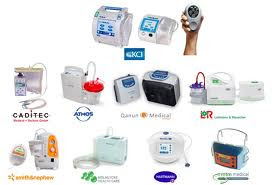NPWT
Negative-pressure wound therapy is a therapeutic technique using a vacuum dressing to promote healing in acute or chronic wounds and enhance healing of first and second degree burns. The therapy involves the controlled application of sub-atmospheric pressure to the local wound environment,[1] using a sealed wound dressing connected to a vacuum pump. The use of this technique in wound management increased dramatically over the 1990s and 2000s and a large number of studies have been published examining NPWT. NPWT appears to be useful for diabetic ulcers and management of the open abdomen (laparostomy) but further research is required for other wound types.
General technique for NPWT is as follows: a dressing is fitted to the contours of a wound and sealed with a transparent film. A drainage tube is connected to the dressing through an opening of the transparent film. The drainage tube is also connected to a vacuum source, turning an open wound into a controlled, closed wound while removing excess fluid from the wound bed to enhance circulation and remove wound fluids. This creates a moist healing environment and reduces edema.The technique is usually used with chronic wounds or wounds that are expected to present difficulties while healing (such as those associated with diabetes).
Negative-pressure wound therapy is a therapeutic technique using a vacuum dressing to promote healing in acute or chronic wounds and enhance healing of first and second degree burns. The therapy involves the controlled application of sub-atmospheric pressure to the local wound environment,[1] using a sealed wound dressing connected to a vacuum pump. The use of this technique in wound management increased dramatically over the 1990s and 2000s and a large number of studies have been published examining NPWT. NPWT appears to be useful for diabetic ulcers and management of the open abdomen (laparostomy) but further research is required for other wound types.
General technique for NPWT is as follows: a dressing is fitted to the contours of a wound and sealed with a transparent film. A drainage tube is connected to the dressing through an opening of the transparent film. The drainage tube is also connected to a vacuum source, turning an open wound into a controlled, closed wound while removing excess fluid from the wound bed to enhance circulation and remove wound fluids. This creates a moist healing environment and reduces edema.The technique is usually used with chronic wounds or wounds that are expected to present difficulties while healing (such as those associated with diabetes).




No comments:
Post a Comment